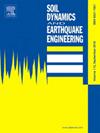利用井下阵列的反土壤动力参数研究小应变场地响应
IF 4.2
2区 工程技术
Q1 ENGINEERING, GEOLOGICAL
引用次数: 0
摘要
以前对场地响应的研究主要集中在重现和预测垂直地震阵列记录的地面运动。本研究评估了利用反土壤动力参数再现和预测金银岛井下阵列和德莱尼公园井下阵列小应变场地响应的能力。首先,根据地震记录,通过地震干涉测量法和频谱比方法获得了地震波速度剖面和瑞利阻尼比等参数。随后,通过比较模拟和观测的地面响应,评估了这些反演土壤动力参数的有效性和可靠性。最后,在一维场地响应分析中,将反演方法与其他考虑空间变异性的方法进行了比较。定量比较结果表明,反演法有效地预测和再现了场地响应,优于依赖单孔剪切波速度曲线和经验模型阻尼比的传统方法。此外,反演法还能更好地捕捉德莱尼公园井下阵列的空间变化。本文章由计算机程序翻译,如有差异,请以英文原文为准。
Investigating small-strain site response using inverse soil dynamic parameters from downhole arrays
Previous research on site response has primarily focused on reproducing and predicting ground motions recorded by vertical seismic arrays. This study evaluated the ability to reproduce and predict small-strain site response at the Treasure Island Downhole Array and Delaney Park Downhole Array using inverse soil dynamic parameters. First, parameters such as seismic wave velocity profiles and Rayleigh damping ratios were obtained through seismic interferometry and spectral ratio methods based on the earthquake records. Subsequently, the validity and reliability of these inverse soil dynamic parameters were evaluated by comparing the simulated and observed ground responses. Finally, the inverse method was compared with other methods considering spatial variability in one-dimensional site response analysis. Quantitative comparisons show that the inverse method effectively predicts and reproduces site response and outperforms the traditional method relying on the single borehole shear wave velocity profile and damping ratio from empirical model. Moreover, the inverse method better captures spatial variability at the Delaney Park Downhole Array.
求助全文
通过发布文献求助,成功后即可免费获取论文全文。
去求助
来源期刊

Soil Dynamics and Earthquake Engineering
工程技术-地球科学综合
CiteScore
7.50
自引率
15.00%
发文量
446
审稿时长
8 months
期刊介绍:
The journal aims to encourage and enhance the role of mechanics and other disciplines as they relate to earthquake engineering by providing opportunities for the publication of the work of applied mathematicians, engineers and other applied scientists involved in solving problems closely related to the field of earthquake engineering and geotechnical earthquake engineering.
Emphasis is placed on new concepts and techniques, but case histories will also be published if they enhance the presentation and understanding of new technical concepts.
 求助内容:
求助内容: 应助结果提醒方式:
应助结果提醒方式:


